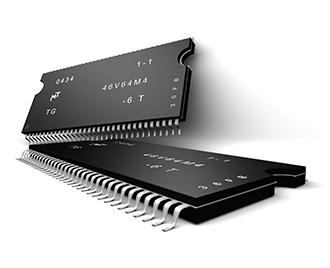Weak memory revenue forecasts from companies like Micron Technology Inc. and Samsung Electronics Co. Ltd. are an indication that the memory market has yet to bottom out, and analysts said price declines, slow demand and global trade issues could upset a quick recovery expected by vendors and drag the struggle into next year.
Memory is the single largest market in the semiconductor sector, accounting for sales of $158.0 billion of the $468.8 billion in total semiconductor sales in 2018, according to the Semiconductor Industry Association. Computers, mobile phones and servers have memory — which is called DRAM — to temporarily hold data critical to running applications and save data.
Two of the world's top three memory makers, Samsung and Micron, sounded alarms of a weak memory market affecting their earnings. Oversupply has led to a drop in memory prices, which has affected profit margins of the companies, analysts said.
 Micron memory chips |
Samsung's Vice Chairman and co-CEO Kim Ki-nam on March 21 said the company is expecting a weak 2019 partly because of a declining memory market and global trade tensions, according to a news report. When reporting fourth-quarter 2018 earnings on Jan. 31, Samsung warned it was expecting weak memory demand, which would affect upcoming first-quarter 2019 earnings.
The decline comes after a prosperous two-year boom that saw memory market record unprecedented growth and hit a new high in 2018. Memory companies generated $70 billion in cash in 2018, but that will decline this year, according to VLSI Research. According to IC Insights, the DRAM market was worth $101 billion in 2018, and will decline to $96.1 billion in 2019. In 2017, the DRAM market was worth $72 million in 2017.
Micron on March 20 announced it expects revenue in the upcoming fiscal third quarter ending in May to be $4.8 billion, plus or minus $200 million. That would be a year-over-year decline from $7.8 billion in the fiscal third quarter of 2018, in which 71% of the revenue was generated by DRAM memory. However, the projection is within consensus S&P Global Market Intelligence analyst estimates of $4.83 billion.
"DRAM pricing weakened more than expected. Our demand outlook for calendar 2019 has moderated, led by somewhat greater levels of customer inventory, weakening server demand at several enterprise OEM customers and worse-than-expected CPU shortages. We believe macroeconomic uncertainty is also contributing to hesitation in buying behavior at some customers," said Sanjay Mehrotra, CEO of Micron, on an earnings call.
Mehrotra said he saw expected DRAM demand to pick up in the second half of the year, but analysts covering the memory market thought otherwise, saying the market was in the throes of what could be a decline that will drag into next year. CPU shortages from companies like Intel Corp. should not have much of an effect on the memory market, analysts said.
China's economy slowing means there is less investment in data centers and reduced demand for phones, computers and electronics, said Risto Puhakka, president of VLSI Research.
"Electronics demand is slower in China, so there's a slower demand for memory," Puhakka said. The trade wars between U.S. and China and events like Brexit have created uncertainty, slowing down technology purchases, and affecting the memory market. Even quick fixes to trade and political issues won't stop the fast decline in memory prices.
"Memory won't recover this year from our view," Puhakka said.
The DRAM oversupply is causing prices to drop, which is affecting profit margins of Samsung, SK hynix Inc. and Micron, the top three memory suppliers, said Jim Handy, principal analyst at Objective Analysis.
The price per gigabyte of DRAM by the end of 2019 could reach $2.50, a drop from $7.50 at the end of 2018. Gross margins will drop to zero percent at the end of 2019 from 75% for some players in 2018, Handy said.
Samsung is finally acknowledging the decline in the memory market, which it refused to earlier, Handy said. "Samsung has come around living in a fairy tale to coming to more a real-world viewpoint, " Handy said.
That first goal for memory companies is to clear out the existing inventory, and that could take a while, Handy said. Micron has already cut capital expenses involved in making memory, and is shifting focus to clear inventory.
Like clockwork, the DRAM industry goes through oversupply and shortage issues every two years, but this memory market downturn is complicated by geopolitical issues, Handy said.
"This one's going to be different because the addition of China to oversupply could extend the duration," Handy said.



